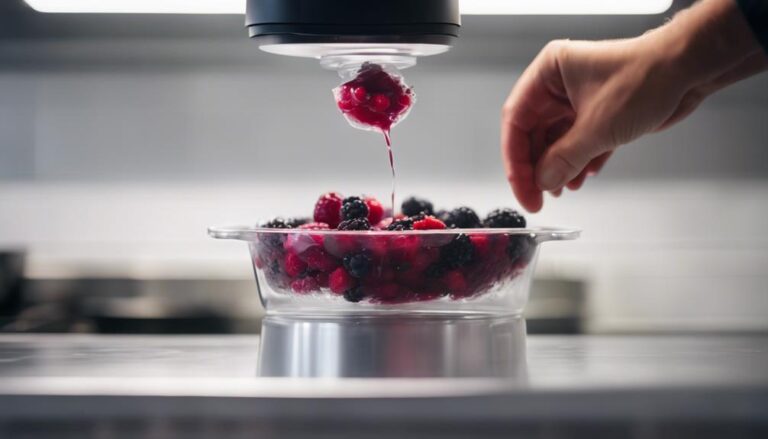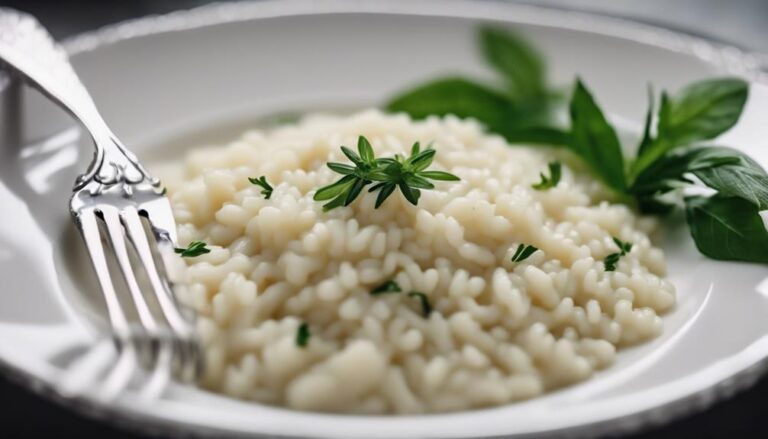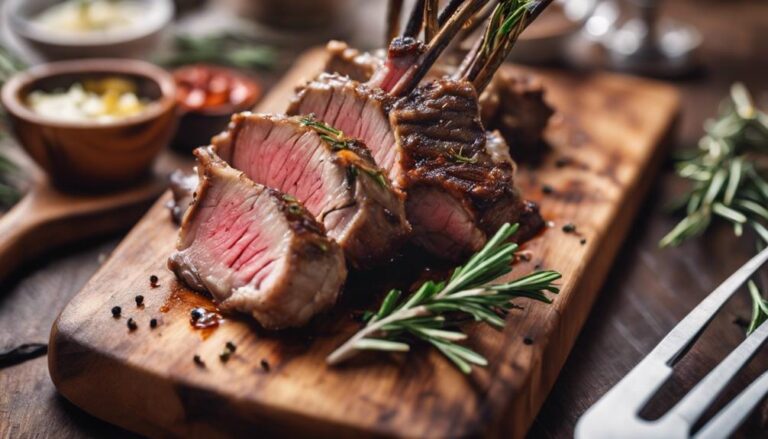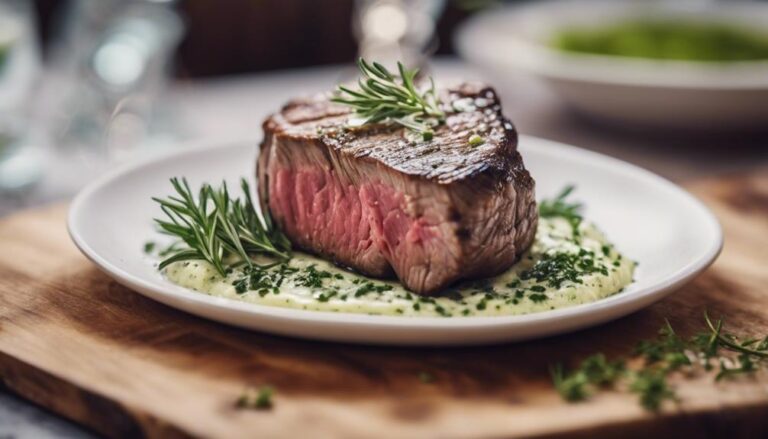Sous Vide Sweet Potato Puree
To create a delicious sous vide sweet potato puree, seal diced sweet potatoes in a vacuum bag with butter, cream, and seasonings like cinnamon. Cook at 194°F (90°C) for the ideal consistency. This method guarantees even cooking, preserving nutrients and flavors. The result is a velvety texture with a rich taste. If you're eager to enhance your culinary skills with this exquisite dish, immerse yourself in mastering this technique for a gourmet experience.
What You Will Learn Here
- Sous vide technique ensures precise temperature control for even cooking.
- Retains natural flavors and nutrients of sweet potatoes.
- Ideal cooking temperature is 194°F (90°C) for perfect results.
- Benefits include consistent texture, flavor, and uniform cooking.
- Experiment with aromatics for enhanced and intense flavors.
Sweet Potato Origin
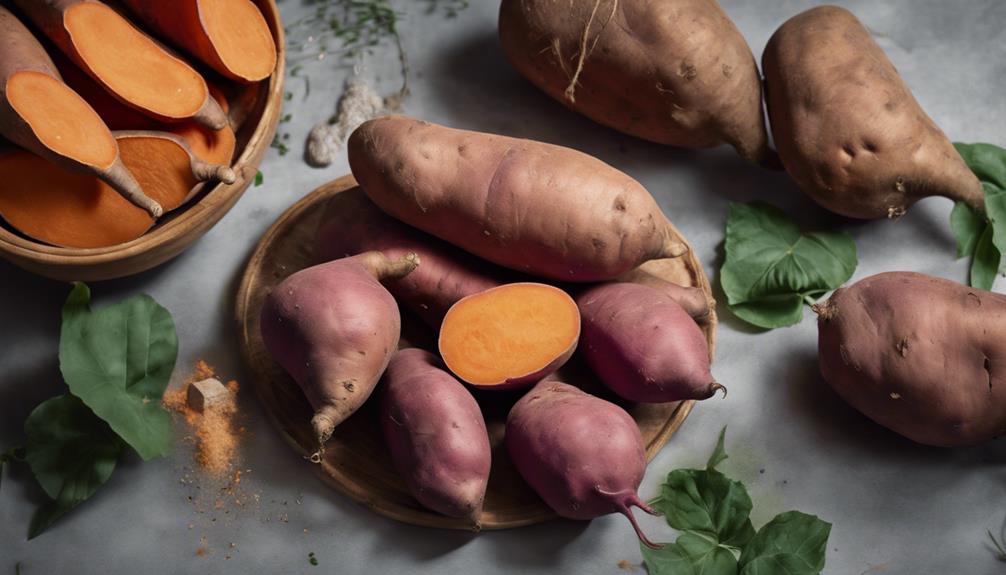
Sweet potatoes, known for their vibrant colors and sweet flavor, come in various varieties that offer unique tastes and textures.
These root vegetables pack a nutritional punch, rich in vitamins, minerals, and fiber, making them a healthy addition to your diet.
From fries to pies, sweet potatoes are versatile ingredients that can be used in a wide range of culinary creations.
Sweet Potato Varieties
Originating in different regions around the world, various types of sweet potatoes exist, each with distinct characteristics and flavors. Sweet potatoes are classified into two main varieties: the moist, orange-fleshed sweet potatoes and the dry, firm-textured sweet potatoes. The moist variety, often called 'sweet potatoes,' is commonly found in the United States and has a soft, sweet flesh ideal for mashing or baking. In contrast, the dry variety, known as 'yams,' is starchier and less sweet, popular in African, Asian, and Latin American cuisines.
Within these two main categories, there are numerous cultivars, each offering its unique taste and texture. Some popular types include the Beauregard, Covington, and Jewel sweet potatoes, known for their consistent flavor and vibrant orange color. On the other hand, the Hannah sweet potato boasts a creamy, pale flesh with a slightly nutty taste. Understanding the different varieties of sweet potatoes can enhance your culinary creations and introduce you to a world of diverse flavors.
Nutritional Benefits
When considering the nutritional benefits of sweet potatoes, one can discover a wealth of essential vitamins and minerals packed into these versatile tubers. Sweet potatoes are a significant source of vitamin A, which is vital for maintaining healthy vision, skin, and immune function. They also contain vitamin C, an antioxidant that supports the immune system and helps the body absorb iron. Additionally, sweet potatoes provide fiber, which aids in digestion and promotes a feeling of fullness.
These tubers are an important source of potassium, an essential mineral for regulating blood pressure and supporting heart health. Sweet potatoes also contain manganese, which plays a role in metabolism and bone development. Moreover, they offer various B vitamins that help convert food into energy and support brain function.
Incorporating sweet potatoes into your diet can help you meet your daily nutrient requirements while adding delicious flavor and vibrant color to your meals. Whether roasted, mashed, or blended into a creamy puree, sweet potatoes are a nutritious and versatile addition to any menu.
Culinary Uses
To explore the culinary versatility of sweet potatoes, consider their rich history and widespread use in various cuisines around the world. Sweet potatoes are believed to have originated in Central or South America over 5,000 years ago. They were introduced to Europe by Spanish explorers in the 16th century and later spread to Asia and Africa through trade routes. This root vegetable has become a staple ingredient in many traditional dishes, ranging from Southern sweet potato pie in the United States to Nigerian porridge made with sweet potatoes and spices.
In Asian cuisines, sweet potatoes are used in both savory and sweet dishes, such as tempura in Japan and sweet potato balls in Hong Kong. In Africa, they're often boiled, roasted, or mashed to create hearty stews and side dishes. Sweet potatoes are also popular in Latin American cuisine, where they're used in empanadas, tamales, and even desserts like sweet potato flan. The adaptability of sweet potatoes in various culinary traditions highlights their global appeal and versatility in cooking.
Sweet Potato Varieties
Exploring different sweet potato varieties can add depth and complexity to your culinary creations. Sweet potatoes come in various types, each offering unique flavors, textures, and colors. Here are four popular sweet potato varieties worth exploring for your next cooking adventure:
- Beauregard: Known for its orange flesh and creamy texture, Beauregard sweet potatoes are versatile and work well in both savory and sweet dishes. They're a popular choice for making sweet potato fries due to their slightly sweet flavor.
- Japanese Sweet Potato: With its purple skin and white flesh, the Japanese sweet potato has a delicate sweetness and a chestnut-like flavor. It's excellent for roasting or baking, bringing a unique twist to traditional sweet potato dishes.
- Garnet: Garnet sweet potatoes have a vibrant reddish-purple skin and orange flesh. They're moister and sweeter than other varieties, making them perfect for mashing or pureeing to create silky smooth textures.
- Hannah: Hannah sweet potatoes have a light tan skin and white flesh. They've a mildly sweet taste and a dry, crumbly texture, making them ideal for roasting or using in salads for a different flavor profile.
Experimenting with these sweet potato varieties can elevate your dishes and introduce new dimensions to your culinary repertoire.
Sweet Potato Mashups
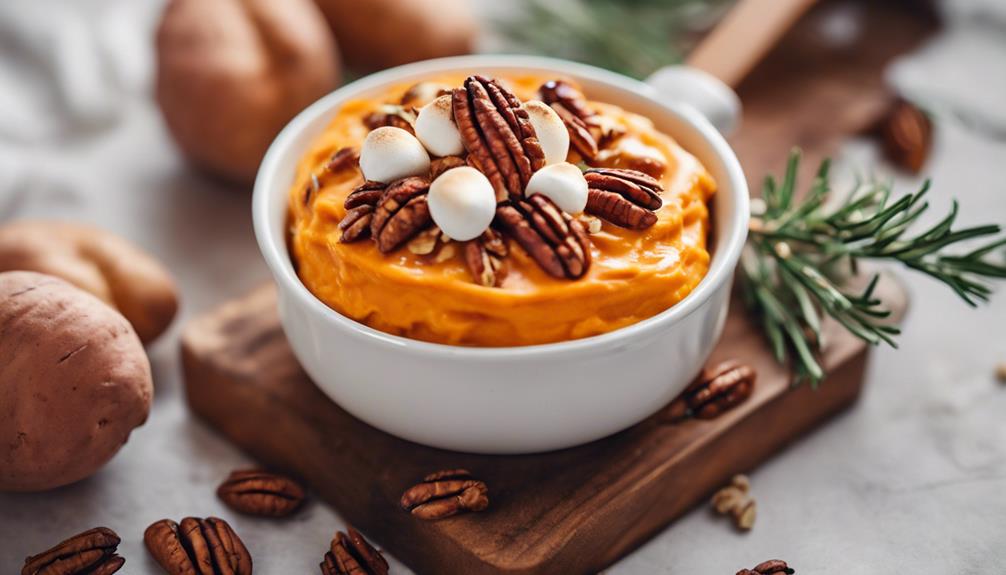
When it comes to sweet potato mashups, you have a world of options at your fingertips.
From a velvety sweet potato blend to a smooth sweet potato puree, the possibilities are endless.
Indulge in a creamy sweet potato delight that will surely elevate your culinary creations.
Velvety Sweet Potato Blend
For a lusciously smooth sweet potato mash, blend the cooked sweet potatoes with butter and a touch of cream until velvety.
To create a velvety sweet potato blend, follow these steps:
- Start by peeling and cubing the sweet potatoes before cooking them until they're tender.
- Drain the cooked sweet potatoes well to remove excess moisture for a creamier texture.
- Add a generous amount of butter for richness and a luxurious mouthfeel.
- Incorporate a splash of cream to lighten the mixture and create a silky consistency.
Smooth Sweet Potato Puree
To achieve a decadently smooth sweet potato puree, consider incorporating a hint of cinnamon for added warmth and depth of flavor. When preparing your sweet potato puree, follow these steps for a velvety texture that will impress your taste buds:
- Choose the right sweet potatoes: Opt for sweet potatoes with a deep orange flesh, like jewel or garnet varieties, as they tend to be creamier when mashed.
- Cook them to perfection: Boil or steam the sweet potatoes until they're fork-tender, ensuring they're soft enough to mash easily.
- Add a touch of sweetness: A drizzle of maple syrup or a sprinkle of brown sugar can enhance the natural sweetness of the sweet potatoes.
- Blend it well: Use a food processor or immersion blender to achieve a silky smooth consistency, making sure there are no lumps left behind.
Creamy Sweet Potato Delight
For an innovative twist on traditional sweet potato puree, explore the world of Creamy Sweet Potato Delight, where sweet potato mashups come to life with unique flavor combinations. When it comes to creating a creamy sweet potato delight, the possibilities are endless.
Here are some exciting combinations to try:
- Maple Pecan: Sweet potatoes blended with rich maple syrup and topped with crunchy pecans for a decadent treat.
- Garlic Parmesan: A savory twist on sweet potatoes with the addition of garlic, parmesan cheese, and a hint of herbs for extra flavor.
- Coconut Curry: Transport your taste buds with a tropical flair by mixing sweet potatoes with creamy coconut milk and aromatic curry spices.
- Cinnamon Apple: Combine the natural sweetness of sweet potatoes with cinnamon-spiced apples for a cozy and comforting dish.
These creamy sweet potato mashups offer a delightful way to elevate your dining experience with a burst of flavors that harmonize beautifully. Experiment with these combinations or create your own unique blend to savor the creamy goodness of sweet potatoes in a whole new light.
Sweet Potato Sous Vide Technique
When using the sous vide technique for sweet potatoes, you'll appreciate the precise temperature control it provides. This method guarantees even cooking throughout the sweet potatoes, resulting in a consistent texture.
Not only does sous vide retain the sweet potato's natural flavors, but it also keeps cooking times in check.
Sous Vide Temperature Control
Maintain precise control over the sous vide temperature for perfect sweet potato results. When preparing sweet potato puree using the sous vide technique, it's essential to set the temperature accurately. Sweet potatoes require a precise temperature range to achieve the desired texture and flavor. Set your sous vide machine to 194°F (90°C) for the ideal cooking temperature. This temperature allows the sweet potatoes to cook evenly without becoming mushy or overcooked.
Consistency is key when it comes to sous vide cooking. By maintaining a steady temperature throughout the cooking process, you guarantee that the sweet potatoes are cooked to perfection. Fluctuations in temperature can result in inconsistent results, affecting the overall quality of your sweet potato puree. Use a reliable sous vide machine with accurate temperature control to achieve the best outcomes.
Benefits of Even Cooking
Achieving even cooking with the sous vide technique for sweet potatoes guarantees consistent texture and flavor throughout the dish. This method ensures that every part of the sweet potato is cooked uniformly, from the exterior to the interior, without any areas being undercooked or overcooked.
By cooking the sweet potatoes in a water bath at a precise temperature for an extended period, you can achieve a perfectly even cook. This consistent cooking results in a smooth and creamy texture, making it easier to mash the sweet potatoes into a velvety puree without any lumps or uneven spots.
Additionally, the flavors are evenly distributed throughout the sweet potatoes, enhancing the overall taste of the dish. The sous vide technique for sweet potatoes not only simplifies the cooking process but also guarantees a delicious and consistent outcome every time you prepare sweet potato puree.
Time and Flavor Retention
To enhance the time and flavor retention when using the sous vide technique for sweet potatoes, consider adjusting the cooking duration and temperature settings accordingly. Sweet potatoes can benefit from longer cooking times at lower temperatures to maintain their natural sweetness and nutrients. By cooking sweet potatoes sous vide at around 183°F (84°C) for 1 to 1.5 hours, you can achieve a creamy texture while preserving their delicate flavor profile. This method allows the sweet potatoes to slowly break down and develop a rich taste without losing their essential characteristics.
For a more intense flavor, you can experiment with adding aromatics like thyme, garlic, or cinnamon into the sous vide bag along with the sweet potatoes. These ingredients infuse the sweet potatoes with additional layers of taste during the cooking process, enhancing the overall dish.
Remember that sous vide cooking is a precise method that requires attention to detail, especially when aiming to retain the best flavors and textures. By adjusting the cooking time and temperature settings thoughtfully, you can create a delicious sweet potato puree that captures the essence of this versatile root vegetable.
Final Thoughts
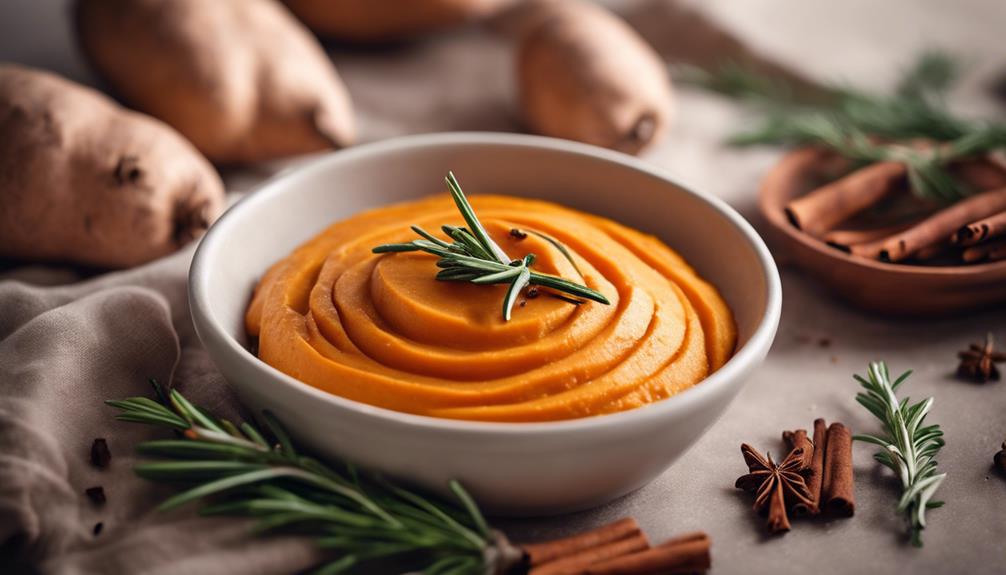
When wrapping up your experience with the Sous Vide Sweet Potato Puree, consider how the cooking method enhanced the natural sweetness of the potatoes. Sous vide cooking allowed the sweet potatoes to retain their inherent flavors and nutrients, resulting in a rich and vibrant taste that may have surprised you. The slow and precise cooking process in a water bath guaranteed that the potatoes were evenly cooked without losing their essence to excess heat or water. This method provided a velvety texture that was unmatched by traditional cooking techniques.
Reflect on how the simplicity of the ingredients – just sweet potatoes, butter, and a touch of seasoning – combined with the sous vide technique to create a dish that was both straightforward and sophisticated. The purity of flavors shone through, showcasing the sweet potatoes in all their glory without the need for heavy creams or excessive spices.
Additionally, think about how the sous vide method offered convenience and consistency. You were able to set the precise temperature and walk away, knowing that your sweet potatoes would be perfectly cooked when you returned. This reliability can be especially helpful when planning meals for gatherings or busy weeknights.
Frequently Asked Questions
Can Sweet Potato Puree Be Made Ahead of Time?
Yes, sweet potato puree can be made ahead of time. By preparing it in advance, you'll save time and guarantee a smooth cooking process later. Remember to store it properly to maintain freshness and flavor.
How Can I Add a Twist to Traditional Sweet Potato Puree?
To add a twist to traditional sweet potato puree, try mixing in a touch of cinnamon or nutmeg for extra warmth and flavor. A drizzle of maple syrup or a sprinkle of toasted pecans can also elevate the dish.
Is It Possible to Overcook Sweet Potatoes in Sous Vide?
Yes, you can overcook sweet potatoes in sous vide. Pay attention to recommended cooking times. Too long in the water bath can result in mushy texture. Keep an eye on the timer for perfect results.
Can I Freeze Leftover Sweet Potato Puree?
You can freeze leftover sweet potato puree. Store it in airtight containers or freezer bags for up to 3 months. Thaw in the fridge before reheating. Stir well to restore the texture. Enjoy your convenient and delicious side dish!
Are There Any Sweet Potato Puree Flavor Variations to Try?
Experiment with various sweet potato puree flavor variations like adding maple syrup, cinnamon, nutmeg, or even a hint of cayenne pepper for a spicy kick. Get creative and tailor the flavors to suit your taste preferences.
Conclusion
To sum up, sous vide sweet potato puree offers a convenient and flavorful way to enjoy this nutritious root vegetable. By employing the sous vide technique, you can guarantee a creamy and smooth texture without the hassle of traditional cooking methods.
Experiment with different sweet potato varieties and flavors to create unique mashups that suit your taste preferences.
Give this sous vide sweet potato puree a try for a delicious and easy side dish option.






